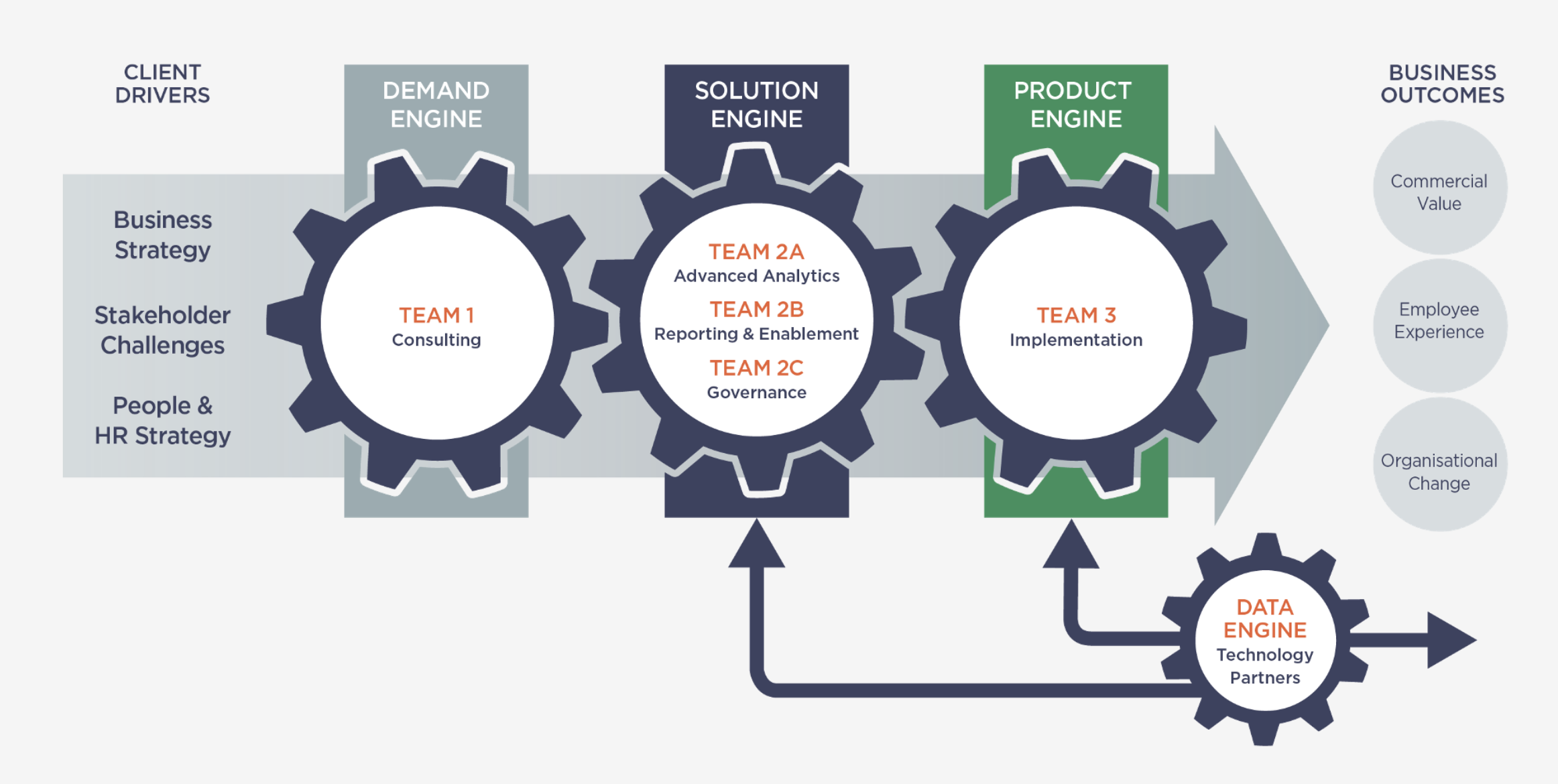What is the Business Value of People Analytics?
The notion that people analytics is complicated and can only help the selected few with real business value is a false assumption. In truth, businesses large and small can utilise people analytics to immensely drive their business forward while remaining competitive in the tight labour market everyone is experiencing today. The key here is understanding the real value of people analytics delivered by watching the current and new trends, developing an operating model for people analytics, and taking action.
What Are the Current Trends With People Analytics?
With the onslaught of changes that have taken place in the world of work, companies are discovering more ways to utilise people analytics to create effective business and HR strategies and countering the challenges they are facing.
Because of this, the first and most impactful trend in the past few years, is the growing awareness of people analytics and how it can drive business forward. Of the CHROs we asked, 90% agree that people analytics is an important part of their capacity to be strategic and develop data-driven decisions. Moreover, the significance and business value of building a data-driven culture has gained popularity in recent years. So much so, in fact that 90% of those CHROs also believe that it delivers business value and 81% state that it enables managers to make “in-the-moment” decisions.
So, since CHROs have a more tactical role with business strategy and are speaking up, companies are listening and giving rise to the next trend in people analytics. And that is the increased investment businesses are making in people analytics. Of the companies we surveyed, 54% state they are planning to increase investment in technology to assist with people analytics. This means that organisations are putting in more time and revenue into people analytics and investing in productise analytics at scale and building a data driven culture for HR.
From the increased investment, the third trend in people analytics is the growth of people analytic teams. And in a time span of less than two years, teams have seen a rise from the ratio of people analytics teams to employee headcount of 1:4000 in 2020 to 1:2900 in 2021. This is a 61% growth.
With the growth in number, the final trend that naturally followed has been the evolution of people analytics becoming more focused on business value. People analytics now put energy not only into the administrative side of HR but are taking on some of the greater challenges businesses have been facing. And there is anticipation for continued growth as turbulent times are not yet over.
How is People Analytics Driving Business Value?
With the trend of companies focusing on the business value of people analytics, teams can provide a wide range of value, making essential improvements with many of the current challenges businesses are facing including:
Employee Experience
People analytics enables organisations to use employee surveys to collect data to shed more light onto challenges being faced ultimately allowing them to improve the overall employee experienced. From there, people analytic teams can then design practices and systems that improve processes for employees to make work easier and more engaging.
Workforce Planning
People analytics can research current trends in the industry and the changes taking place and prepare businesses with HR strategies. They can do this by advising what skills are required for the future to get work done, how to recruit for those set skills or means for reskilling the current workforce through training or a talent marketplace.
Employee Productivity
Running reports and delivering surveys directed to work, people analytics can follow patterns that show where there are bottlenecks in work, capture insight into what jobs need more support, where management is failing to support employees and uncover ways for improvements.
How Leading Companies Found Business Value With People Analytics
By following the trends with leading companies, we not only discovered that they were already investing in people analytics and have been doing so for years, but we uncovered how they went about the process and the business value that came about. Some examples:
Colgate Palmolive: Improving Diversity and Inclusion
The events in 2020 escalated Colgate’s efforts to improve DE&I within their organisation. They knew already they had a lot to do to raise awareness of racial injustice practices. After making the commitment, Colgate brought on a new Chief Diversity Officer who worked closely with the people analytic teams to create metrics and intuitive “storyboard” for HRBPs to use with their stakeholders. The results empowered new data-driven decisions regarding their approach to recruitment, retention and engagement.
Uber: Enhancing Employee Engagement
Affected by the pandemic like so many other companies, Uber discovered that employee engagement and employee listening were essential for their employees and for business success. In sight of their goals, Luye Change and her team developed a continuous listening program that focused on understanding how people were handling the transition to remote work, a challenge most companies were tackling.
From their efforts, Uber found it key to not only listen to employees, but to act on their responses. This was highlighted when they began the process to bring staff back and by listening to the concerns of employees, developed more flexibility and preferences to hybrid work approach.
What Are Some New Operating Models for People Analytics?
With investment into growing teams for people analytics, also comes the need to invest in creating an operating model for people analytics. An operating model helps to streamline their work and be more efficient. The process to do this takes the client drivers and converts them into tangible business outcomes that is split into three key areas, or what we like to call Engines. These engines are then broken down further to address the teams that would be handling the functions and what their primary goal would be.
Demand Engine
Demand Engine consists of the consulting team that engages with business stakeholders to make sense of and translate business strategy and challenges into hypotheses that can be tackled by the Solution Engine
Solution Engine
Solution Engine includes the Advanced Analytics, Reporting & Enablement and Governance teams that manages and produces analytic solutions. They work in collaboration with the organisations’ data engine. Here the Governance takes on the responsibility of prioritising projects, upholding the highest ethical standards and manages data stewardship.
Product Engine
Production Engine is the Implementation team who ensures the effective design and product management of analytics solutions. It includes the associated project management and change management to provide the effective adoption of each solution.
Leading companies are building a people analytics operating model because they understand the benefit to setting a process up. From the companies we surveyed, 39% of them already have roles across all three engines. Of those, 93% are confident of the value derived from this.
How to Take Advantage of People Analytics
Implementing people analytics into your organisation can appear to be a daunting task. You may not know where or how to get started. By watching the trends and understanding that people analytics drives businesses forward, it is much easier to take action and commit to investing in people analytics like leading companies do.
Consider how Microsoft improved company culture through the use of people analytics. Kathleen Hogan CHRO at Microsoft states:
“So it is not just how do you go from data to insight, but then can you operationalise them and somehow institutionalise those insights in terms of your tools, your manager, training, and your people processes. Again, we are on a long journey there, but that is the huge opportunity I think we have.”
We are constantly monitoring people analytics and speaking with leading companies that pave the way. We believe you too can see real results from people analytics like Microsoft, Uber and Colgate. But know that you do not need to do this alone. There are resources available that can help you along the way. From tools and technology that streamline the process to HR training programs to upskill yourself and your staff with the ability to be data driven, business focused, and experience led. Plus, there are coaching services that stay on top of new trends and outcomes and can will guide you every step of the way.
Upskill Your HR & People Analytics Teams with the myHRfuture Academy
To succeed, HR professionals need to become more data driven, business focused and experience led – to acquire the skills necessary to process, produce and leverage digital information.
The myHRfuture Academy supports thousands of HR professionals in building the skills that they need to succeed in the future. Our expertly curated, bitesized learning content allows you to build your knowledge and get certified in skills such as People Analytics, Digital HR and HR Technology, Design Thinking and Workforce Planning.
ABOUT THE AUTHOR
Ian Bailie is an advisor to Insight222 and consultant for start-ups focused on HR technology and People Analytics, including Adepto, Worklytics and CognitionX. In his previous role as the Senior Director of People Planning, Analytics and Tools at Cisco Systems, he was responsible for delivering the tools and insights to enable and transform the planning, attraction and management of talent across the organisation globally. Ian is passionate about HR technology and analytics and how to use both to transform the employee experience and prepare companies for the Future of Work.







